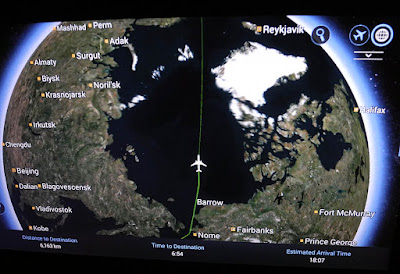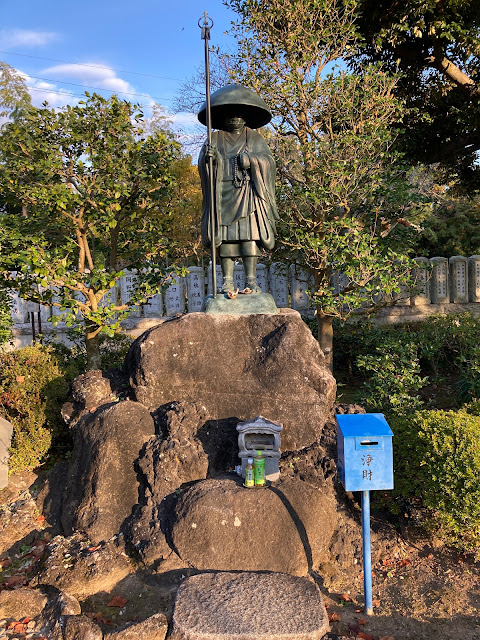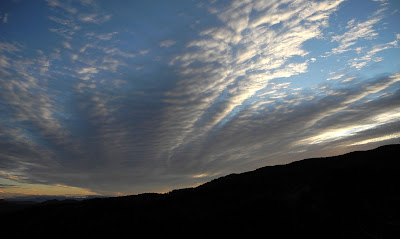5 November, 6am: frost pillars, as wished for yesterday, heave obligingly out of the soil as we tackle the steep hill behind the hut. Fixed ropes help us to pull over greasy steps. At least there are no more slippery tree roots to stumble over, now that we’ve left the treeline. And the packs are lighter, as our bivvy gear has stayed at the hut.
We’re climbing the Pitch of the Beautiful Women (美女坂), observes the Sensei gleefully. Gaining height, we haul the Northern Alps into view over the intervening ridges – there’s Yari silhouetted against a chilly dawn glow, and Tateyama too. The latter, another dormant volcano, is the only mountain other than
Hakusan that has paths known as Zenjōdō. And, intriguingly, it also has a place named for Beautiful Women (美女平). It's as if the two mountains have been conversing for centuries over this aery gulf between them.

Now we start across a frozen marsh. The scenery is like a miniature Oze, except that the boardwalks are frosted; we tread them warily. The Sensei points to a lily’s skeleton; in early summer, this would be a meadow of nodding yellow blooms. That would more than justify its name of Flower Garden (花園).
After the Trial of the Boardwalks (nobody fell into the marsh), we start on a grassy traverse. Across the valley is Hyakuyojō-no taki(百四丈滝), a waterfall purporting to be no fewer than four hundred chains high. Lurking in the early morning shadows, it is heard more than seen; we will inspect it properly on our return, when the light is better.
Ahead the Sensei points out Ōnanji. As this peak serves as the
oku-miya (inner sanctuary) of the Hakusan shrine, it should make a fitting endpoint for our passage over this Zenjōdō. It doesn’t look that far above us.
This misapprehension is corrected when the traverse path drops away in front of us. As it would be too demoralising to lose a hundred metres of height all at once, we sit down on a boulder of pitted lava – a discreet reminder of Hakusan’s
volcanic origins – and refresh ourselves with the Sensei’s home-grown sweet potatoes.
The sun is now high enough to warm us on our lava pedestals, and the wind has dropped too. But over there on Ōnanji, a filmy mist starts to veil the summit. We take the hint not to linger. While we scramble down to the col, what started as a mere wisp of vapour congeals into a fully fledged cap cloud.
Zig-zags take us down to a col. Its fluttering expanse of panda grass is a lost world halfway between earth and sky. A small pond, Abura-ike, would charmingly reflect the travelling clouds, except that it has long since frozen over. Then the path tilts upwards again. A glance at the map shows us to have embarked on Nagasaka – the Long Slope.
If only the slope were just long. The path is now entrenched in a steep grove of creeping pine trees, which rake us with their ice-glazed fronds as we push through them. When we emerge from this Austerity of the Hoarfrost, we find that a fox has made off with our visibility. But, no matter, my altimeter says we’re within a hundred metres of the summit.
Altimeters, as I should have learned yesterday, are but fickle guides on a Zenjōdō. The Sensei knows better; this is her local mountain, after all: “If we don’t turn back now, we’ll be walking back down in the dark,” she says. But, heck, I object, it’s only ten and we’re nearly there. What if I run on ahead and see if I can get to the top in the next half hour?
My proposal is not endorsed, but neither is it vetoed. Taking this as an assent, I push on upwards into the freezing fog, giving myself an extra half an hour to make the summit. Soon it starts to dawn on me that we're not yet on the slopes of Ōnanji, but only on what the Swiss would call a “Vorgipfel”. Or, depending on how you read the map, just a Vorgipfel of the Vorgipfel ...
Doubt is already creeping in when I come to what looks like a fork in the path – if one of us went astray, we would never find each other in this murk. And what is the point of summiting without the Sensei? For shame, even to think of it. I turn back and, a few minutes later, I’m relieved to see her still coming up. “You're right,” I admit, “this is no weather for splitting the party.”
Zenjō (禅定),
an expert on the Tateyama religion explains, refers to a state of mind during meditation. Moreover, it indicates austerities or 'meditations' on sacred mountains. Just as we start down, the Kaga Zenjōdō presents us with another of its revelations. When the clouds lift, we see the whole ridgeway uncoiling below, like the crenellated spine of a dragon. In this vast landscape - I realise we haven't seen another soul for two days - the two of us suddenly look very small.
A similar feeling seems once to have assailed Arne Naess, the alpinist/philosopher who famously turned back before reaching the summit of a
sacred peak in the Himalaya. In his essay on
Modesty and the conquest of mountains, he wrote that “The way is such that the smaller we come to feel ourselves compared to the mountain, the nearer we come to participating in its greatness,” before adding enigmatically, “I do not know why this is so.”
It takes a long time to retrace our steps. All too soon after we pick up our kit from the bivouac hut, the lingering clouds turn gold. In the fading light, those slippery tree roots send me sprawling more than once. The Sensei was right about turning back on time. The last zig-zags down to the valley must be illumined by the light of our headtorches. Walking back to the car, along a forest track, we wade through pools of moonlight so bright they seem almost to buoy us up.























